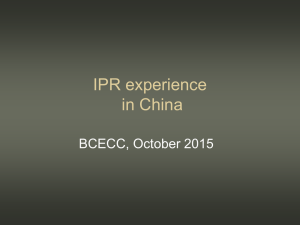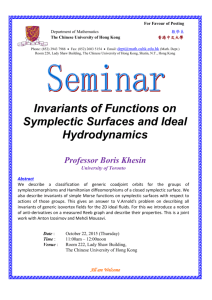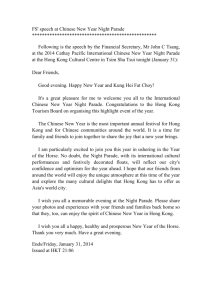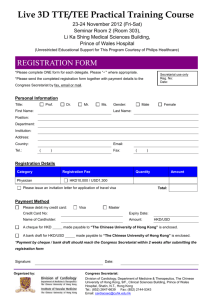Case Workshop - Contracting - Private Healthcare in Developing
advertisement
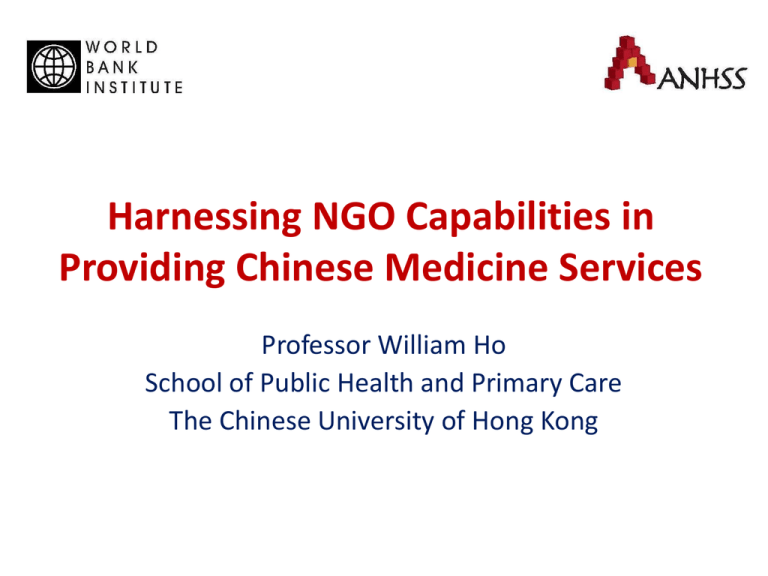
Harnessing NGO Capabilities in Providing Chinese Medicine Services Professor William Ho School of Public Health and Primary Care The Chinese University of Hong Kong HMP-Framework: Instruments Grow A well-functioning part of the private sector Harness Convert A large number of provider NGOs Government shifting from funding to purchasing • NGOs historically providing Chinese Medicine services in Hong Kong Could contribute more by expansion could be leveraged to serve public patients From “NHS” to social health insurance system could leverage private resources to expand / improve services currently provide by goverment could be improved by active management of service quality • Public-PrivatePartnerships in investment, delivery, or management Policy and Programmatic Instruments • • • • Regulation Contracting Training/Information Social marketing • Social franchising • Info. to patients • Demand-side (incl. Vouchers) Source: Adapted from Harding & Preker, Private Participation in Health Services, 2003. • EQA / Accreditation • PPP transactions • Enable environment improvement Outline for Presentation • Introduction of a new public service funded by the government • Strategic considerations: • Strengths and weaknesses of public system • Strengths and weaknesses of private system • Potential benefits of synergy between the two • Key take-home messages Questions to Participants • To what extent do people in your country use alternative medicine/Chinese medicine? • Are there government regulations on alternative medicine/Chinese medicine? • Is there government funding on alternative medicine/Chinese medicine services? • Is there public provision of such service, and if so, any opportunity for PPP? Use of Chinese Medicine in Hong Kong >=15 yrs, Hong Kong Thematic Household Survey, 2005 (N=36,724) Visited a healthcare professional in the past 12 months: (n=18,087) Visited western practitioner only: 80.23% Visited both western & CM practitioners: 16.60% Visited CM practitioners only: 3.17% Situation Before Change • Public hospitals and clinics under the Hospital Authority provide heavily subsidized western medicine service only • NGOs and private solo practitioners provide CM out patient services to community, mostly through out of pocket payment • Government provides token financial support to some NGO for the poor • Affordable but low/variable quality Return of Sovereignty 1997 CM Policy under New Government • 1997 – Chief Executive of HKSAR announced commitment to CM development • 1998 – First Bachelor of Chinese Medicine course in local university • 1999 – Chinese Medicine Ordinance passed • 1999 – The statutory Chinese Medicine Council of Hong Kong established • 2000 – Registration of CM practitioners began Policy Goals • Public provision of subsidized, regulated CM service in all 18 geographic districts to meet community demand • Develop CM as important component of Primary Care, especially for chronic diseases • Set the benchmark of modernized CM service management through the public clinics Issues of Concern • Public sector does not have experience in running CM service • Skepticism/opposition from western-trained doctors and nurses in public hospitals and clinics to Chinese medicine • How do you pay CM practitioners? • High caliber CM practitioners few in Hong Kong as compared to Mainland China Questions to Participants • What are the strategic questions regarding contracting out the service to private sector? • How to assess capabilities and potentials of the private sector? Strengths of Public Sector • Well established Hospital Authority system • Management know how in: Service planning and facilities building Human resources management and professional training Clinical quality management including risk management Pharmacy system, IT infrastructure Economy of scale and financial know how • Potential for forging western-CM collaboration Weaknesses of Public Sector • Need to overcome professional staff resistance • No experience in running CM services • Rigid pay and benefit structure • Apprehension of private sector on unfair competition from the Hospital Authority • No reliable data on costing for budgeting purpose Strengths of NGO Sector • Long history of providing CM service • Well established image of serving the community and the poor • Attracts community donations and support • Competition among different NGOs for government funding may lower the cost • Flexibility in staff terms and salary • Connections with Mainland for CM experts Weaknesses of the NGO Sector • CM service largely run as solo clinics of CM practitioners • No organized training and career structure • Lack of know how in proper management including pharmacy and clinical risk management • No access to western medicine counterparts Private Sector Assessment • Experience and track record of NGOs running CM services • Organizational leadership and commitment • Proactive and learning attitude • Sound financial health and internal management • Attractive proposal submitted Tripartite Model 1. Each clinic attached to an HA hospital and funded through HA 2. Run by an NGO through time-limited service contract 3. In association with a local university for CM research collaboration • Phased approach – learn from pilots Phase 1 - 2003 • Enhancing some existing, well-run CM clinics of Schedule II hospitals (those managed by HA but still owned by NGOs) Tung Wah Hospital – Tung Wah Group – University of Hong Kong Yan Chai Hospital – Yan Chai Group – Hong Kong Baptist University Nethersole Hospital – Nethersole Group -The Chinese University of Hong Kong • Test case funding and contracting Questions to Participants • What are the benefits to government? • What are the benefits to NGOs? • How government can ensure achievement of public aims: 1. 2. 3. 4. Serving the poor Ensure and improve quality Ensure efficiency and cost-effectiveness Forge collaboration between western and Chinese medicine practitioners New Era for CM Service in Hong Kong Introducing Modern Management Assessment Clinic Modern Pharmacy CM Information System Innovation through NGO • Flexibility of ranking and remuneration structure for CM doctors, nurses, dispensers • Relation of NGO and Mainland cities is key to recruit top level CM Professors from China • NGOs operate services outside the funded scope (e.g. Special clinics, Acupuncture and Tui Na) for revenue generation • NGO seek donations for worthwhile activities such as joint western and CM treatment/research Government Control Contracting and Franchising • Stipulates mode of operation • Stipulates standard fees for funded services • Stipulates 20% free quota for the poor • Stipulates guaranteed employment of 5 local CM graduates per year per clinic • Stipulates quality and quantity targets • Mandatory use of a CM Information System Expedient Completion of 14 Sites • 2003 – Tung Wah Center, Yan Chai Center, Tai Po Nethersole Center • 2006 – Tang Shiu Kin Center, Tseung Kwan O Center, Yuen Long Center, Yan Oi Tong Center, Ngau Tau Kok Center, Kwong Wah Hospital Center, Tung Wah Eastern Hospital Center • 2007 – Ha Kwai Chung Center, Eastern Center, Wong Tai Sin Hospital Center • 2008 – Fanling Center, Buddhist Hospital Center • 2009 – Shatin Center, West Kowloon Center Other Collaborating Centers • In 4 centers, the NGOs did not consider it advantageous to receive HA funding and comply with government rules TWGHs - Kwong Wah Hospital, Tung Wah Eastern Hospital, Wong Tai Sin Hospital HKBU - Center at Queen Elizabeth Hospital • But the 4 centers offer similar services to the public and participate in the same IT platform and training scheme Benefits to Government • • • • Short start up time Less capital resource input Capitalize on joint reputation of NGO and HA Lowered contracting fee per clinic after tested out market on first batch • NGOs compete with each other through quality Benefits to NGOs • Playing an active part in service provision rather than passive (e.g. in western medicine) • Service expansion with steady funding • Government investment of facilities • Revenue generation from flexibility to offer nonfunded services • Enhancement of image and profile • New areas for fund raising • Benefit through collaboration with HA and structured training of practitioners Monitoring and Evaluation • Through Clinic Management Committee mechanism with tripartite representation and HA representative • Regular financial, human resources and activities reporting • Central committee on training of CM graduates • Overall budget control, coordination and service planning through an HA subsidiary Take Home Messages • Successful PPP schemes must bring benefit to all involved parties • Government leverages on the existing strengths, experience and flexibility of NGOs • NGOs leverage from steady funding and management know how of government • Public objectives must be clearly defined, contracted for, measured and monitored • Synergy should ensure 1+1 > 2 THANK YOU


